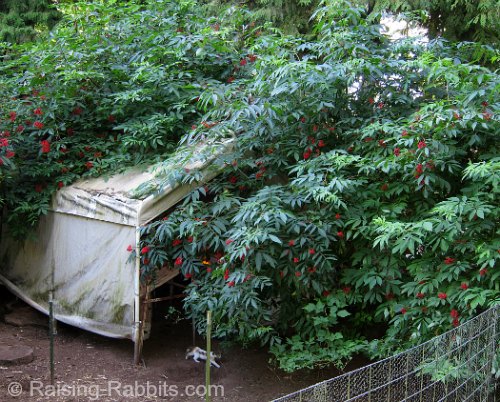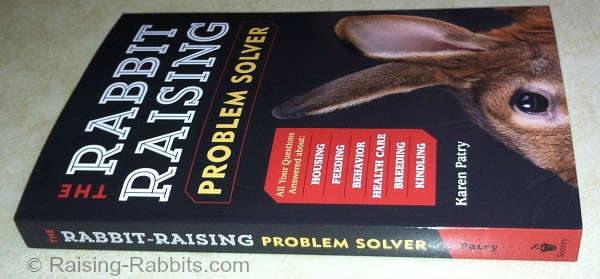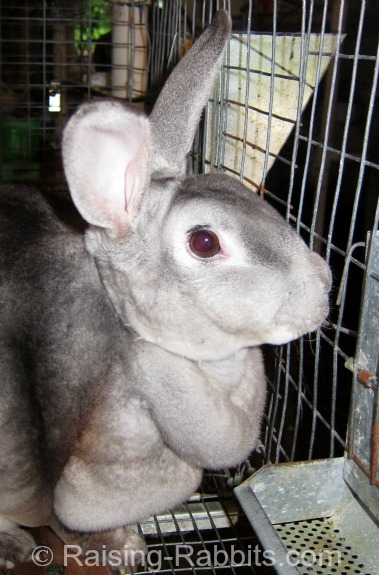| Back to Back Issues Page |
 |
|
Rabbit Rhythm #49 – Rabbit cancer in older rabbits, plus managing summer heat July 02, 2014 |
Rabbit Rhythms of JulyJuly in most areas of the northern hemisphere can be brutally hot. Additionally, the extra heat can bring clouds of flies. How are you doing with keeping your rabbits fly-free and cool? Check out the tips at these pages if needed: Natural and Safe Fly Predators - Fly predators provide very effective fly control in your rabbitry. But hurry – it is best to place the predators in the barn before the major heat starts. Get ideas for keeping your rabbits cool through the brutally hot summer
Notice that the front of the canopy is completely open. The 15-20 feet of greenery at and above the entry provides a buffer that cools the air before it circulates into the barn.
Rabbit Raising Problem SolverRabbit Raising Problem Solver hit the bookstore shelves in early May, 2014. I wrote this book due to the many questions flooding into the Raising-Rabbits website. It was not physically possible to answer all these questions individually, much as I wanted to and as hard as I tried to do so.Instead, I did the next best thing – put the answers into a book. Storey Publications did a great job with everything! On the weekend of June 21, at an American Rabbit Breeders Association (ARBA) rabbit show, I got quite a few comments from those who had purchased the book:
Visit Rabbit Raising Problem Solver for more info, and to order your own autographed copy.
Healthy RabbitsIncidence of Cancer in Older RabbitsCompared to various other mammalian species, rabbits tend to have an especially high rate of uterine cancer (endometrial carcinoma). Nearly all of the cancers did not occur until the rabbits were 4 years old or older.Interestingly, cancer rates varied relative to the breed of rabbit. In rabbits aged 4 - 9 years old, the incidence of endometrial cancer was as follows:
One colony of rabbits (Phipps) experienced an approximate 60% rate of cancer in rabbits over 4 years old. In another colony (Greene), the rate soared to 79% in rabbits that reached 5 years old. In a third colony containing Dutch rabbits, the rate of neoplasms (cancer) was 20%. Nearly all the Dutch rabbits were 4 – 7 years old by the time the tumors were identified. “Senile atrophy of the endometrium,” or menopause if you will, was a particular trigger for the spontaneous development of endometrial adenocarcinoma. Tumors were often “multicentric,” or affecting more than one spot within the double-horned uterus, and in some animals also metastasized (spread) to other areas, including abdomen and lungs. Pet Rabbits: The statistics make an excellent case for spaying your female pet rabbit at around 3 years of age or even a bit sooner. In most cases, this will ensure that the reproductive organs are removed before becoming cancerous. Recognize also that not spaying a rabbit does not necessarily doom it to death by cancer. Not all rabbits will develop cancer, but removing the reproductive organs certainly will eliminate any chance for developing uterine cancer in your pet rabbit. Working Rabbits: For the rabbit farmer, recognize that at 3+ years of age, the chance for cancer in your does rises sharply in most breeds of rabbits after age 4 years old. Waning productivity is a sign that “menopause” is setting in, and that the likelihood of reproductive cancer has begun to increase. Therefore, plan to retire does from your breeding program at around 3 years old, or know the risks and proceed according to your best discretion.
Like this newsletter?Maybe your friends would too...
Your friends at Raising-Rabbits.com wish you a wonderful July, 2014. Happy summer, and enjoy your rabbits!
|
| Back to Back Issues Page |


